The Zettelkasten Method: nonlinear Zettel note format
"A Zettel is a Note."[1] I clearly remember the first time I read this line. The term is German, and the whole idea of a Zettelkasten was a foreign subject. Thankfully, I could wrap my brain around an index card file or “slip-box,” because I had made a feeble attempt years ago to keep my growing pile of notes in just such a box. And because I was old enough to have used a library card file to look up books, I felt I might be able to handle this methodology for note-taking created by Niklas Luhmann.
My first recorded journal entry is around age 5 ---just a few lines of neatly penciled words describing what I did after school. I have scattered notes and journal entries through junior and high school; however, it wasn’t until I read The Majesty of Books by Stirling W. Sill (around age 21) that I went full in on note-taking and keeping a journal.
I went digital somewhere in my forties and by the time my note-taking slowly ground to a halt, I was in my late fifties. My system halted at about the 30,000 entries mark, primarily because it had become so unwieldy that I couldn’t find anything. Journal entries by date were easy to find, but not necessarily ideas expressed in the entry. I had developed a reasonable way of tracking my hiking adventures by State, County, and quadrangle, but I couldn’t apply the same tracking concept to my notes. Keywords were more confusing than ever-swelling to around 1,400; listing such general references as to be utterly worthless. The same was true with Tags.
In May of 2019, I stumbled upon a book entitled How to Take Smart Notes, by Sonke Ahrens. I came close to buying; however, a review said, “save your money and visit the website: Zettelkasten.de.” So I lurked on the website, reading blogs and the forum before joining October 2019. I’m not an active participant in the forums, but I felt an instant kinship with Christian and Sascha as many of their early blog posts included several of the same books I had read and taken notes on.
The Zettelkasten methodology seems simple enough, and I won’t describe the dozen or so attempts I’ve made to get the methodology to work within my existing notes. Unfortunately, I have discovered several ways in which it doesn’t work and it is frustrating to have to unravel an attempt at something that I knew should make my life easier, not harder. However, having arrived at a smooth-running platform makes me no worse for wear, even given the two-year trial period. I knew a Zettelkasten is what I wanted, similar to how I knew that David Allen’s Getting things Done methodology was the way to organize my personal and work life. And just like GTD, creating a working Zettelkasten was taking time.
I debated starting from scratch seriously, but I had thousands of notes with which I had a profoundly intimate relationship. I had spent years reading pondering and memorizing many of my favorite notes through a form of spaced repetition. I was jotting down personal ideas, experiences, and my prose with each review. I also had thousands that would probably fall under The Collector’s Fallacy; however that fallacy doesn’t bother me as much as knowing I was leaving too much unsaid on the table.
I dismissed Structure Notes right away as too much busywork. Argonsnorts in the forum called it “housekeeping, and man, I really didn’t want to do that.” [2] I could relate. I tried Luhmann IDs (twice) to no avail. A fixed ID is required to reference each note, and I had moved from title to Luhmann IDs before finally settling on Date/Time UID.
My biggest roadblock was the Zettel note itself. I have dozens of examples that I copied from the forum group, and try as I might, I couldn’t get the hang of writing this simple piece. A Zettel note is the backbone of a Zettelkasten, so I knew I was in serious trouble. The problem with writing a Zettle note, like a Structure note, seemed so redundant to me. I already had the notes; I just needed a way to tie them together.
Enter “nonlinear formats for idea development.” A note I created in March 2020 from the website Lesswrong and written by abramdemski. The blog’s title is The Zettelkasten Method and is listed as a whopping 62 min read. [3] Most of the blog is redundant if you are familiar with the methodology, but what caught my attention as the author described several tools he had used to implement the method. Buried in the 62 minutes were 28 words that have become the heart of my implementation.
"Workflowy introduced me to the possibility of nonlinear formats for idea development... Suddenly, I could continue a thread anywhere, rather than always picking it up at the end."
I don’t use Workflowy; however, the term “nonlinear format” gnawed at me, and I had made a journal entry on that date saying, “in my mind’s eye I could see me making notes and following links from thought to thought.” Truthfully, if I had said ”following links from note to note,” I probably would have solved my particular puzzle faster than I did.
My notes are now fixed, and I call them Reference Notes. They follow the format beautifully illustrated by forum member Gescho in his post The Zettelkasten as a Lattice of Thought Strings. [4] My software allows me to hard link notes to note and color code the “sequential notes” with green. (TheBrain.com)
The individual notes follow the existing formats discussed within the forum, i.e., UID, Title, (I don’t use the date of creation because my software keeps track of that), (I also don’t use Keywords or Tags for reference notes). And, of course, a citation or reference. 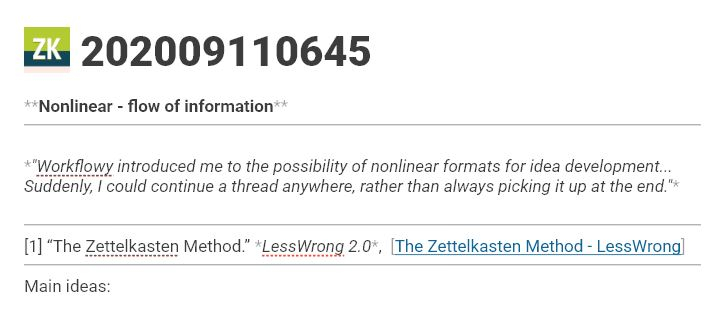
What has changed is the way I write a Zettel note itself; rather than draw to my Zettel note all the various ideas scattered across my web. Instead, I let the Zettel note chart a course across the web through links. I’ll explain.
In my archive, I have a reference note entitled A Zettel is a note. 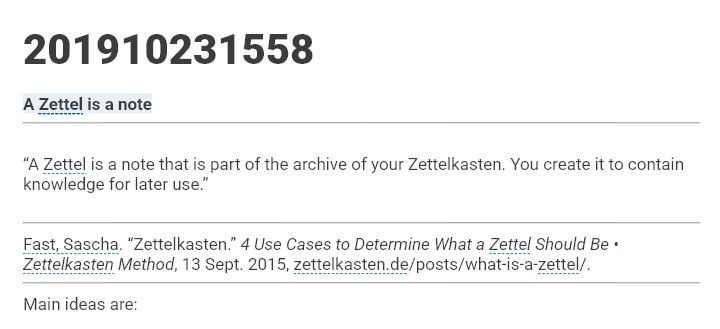
The note is a quote from Sascha’s blog; in the section are two distinct topics. “A Zettel is a note,” and the archive for your Zettel notes is called a “Zettelkasten.” Bear with me through the elementary explanations. I then created a Zettel note called “A Zettel is a note,” which I know is not very original. However, the Zettel note is only an Entry Point to access the thought string or discussion thread (using Gescho’s fantastic imagery once again).
Once I access the entry note, I have three options. First, continue to the following note sequence via the UID link. In this case, it is the first note regarding Zettel’s that we looked at previously. It is on this note that I make my observations and start my Zettel note. 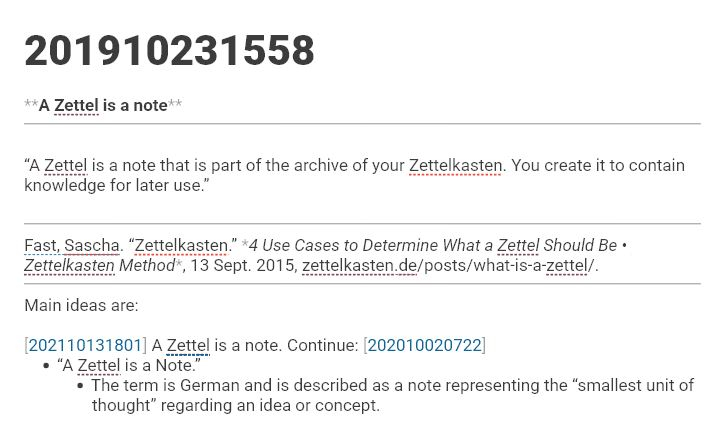
Second, I try to find some common ground with other notes, and if appropriate, write in a “common idea.” If a common idea doesn’t fit, I create a new one or write my observations. One could argue that I am making a Structure Note inside my Zettel note, which is probably a valid argument. However, I don’t link individual thoughts, and the software keeps track of all associated ideas through automatically created backlinks. 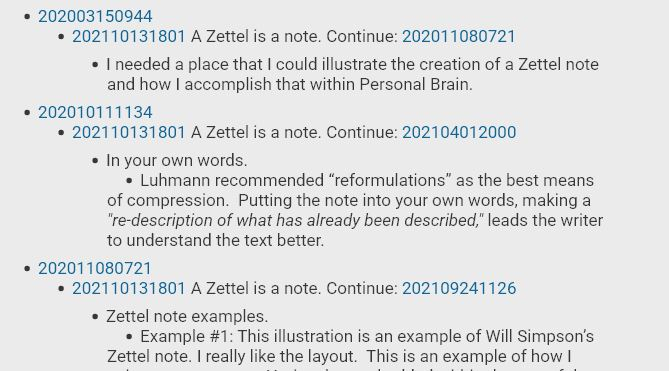
Third, when a quote discusses more than one topic, I repeat the process. If I have an existing Zettel thread, I scroll through the backlinks until I find an appropriate place to insert the new note or not finding one, I jump to the last Zettel note which reads: “Continue: end” and add the new link. 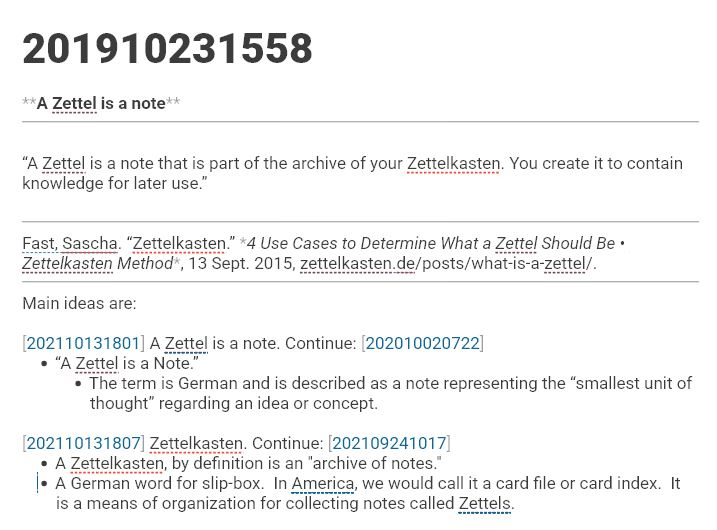
In conclusion, I would like to reference two ideas from Eva Thomas.
”Luhmann considered referencing to be the crucial feature of his system.”[5]
”Quality comes from the network of links with other notes, not from the content itself, because following the links through the web of thoughts will enrich our thinking with unexpected discoveries in a way re-reading the content of separated notes never will.”[6]
Being able to create a nonlinear path helps facilitate this journey. Serendipity occurs when two paths cross on a note which is both surprising and enlightening. Stephen King said it best, ”two previously unrelated ideas come together and make something new under the sun. Your job isn’t to find these ideas but to recognize them when they show up.”[7]
[1] Fast, Sascha. “Zettelkasten.” 4 Use Cases to Determine What a Zettel Should Be • Zettelkasten Method, 13 Sept. 2015, zettelkasten.de/posts/what-is-a-zettel/.
[2] Argonsnorts. (2020, March 23). Is the three-layer structure of evidence a generally useful principle? Retrieved October 06, 2020, from Is the three-layer structure of evidence a generally useful principle? — Zettelkasten Forum
[3] “The Zettelkasten Method.” LessWrong 2.0, The Zettelkasten Method - LessWrong
[4] Gescho (2019, September 4). Retrieved from https://zettelkasten.de/posts/lattice-of-thoughts/
[5] Thomas, E. (2020, August 23). Understanding Zettelkasten - What it means to communicate with the slip-box. Retrieved September 11, 2020, from https://medium.com/@ethomasv/understanding-zettelkasten-d0ca5bb1f80e
[6] IBID
[7] Knowledge Processing System (PKM) for knowledge workers. Tiny Little Businesses. (2021, June 2). Retrieved October 19, 2021, from https://tinylittlebusinesses.com/zettelkasten-method/.
Howdy, Stranger!
Comments
@Steve625
I read through your post carefully, trying to understand the nuances of what you were saying. In particular I tried to understand how what you are doing differs from my practice when using The Archive, and how your practice might give me greater insight into my ZK.
My initial "take" on your post is that you are able to visualize the thought strings that you are creating as you enter new zettels (or new pieces of information), i.e., that you are able to both create and modify the architecture of your thought strings (and your ZK) as you go (rather than just visualize them after the fact).
It seems that your lattice of thought strings can also link directly to reference material and not just to your zettels.
I wonder how, as your ZK becomes more complex, you handle intersecting thought strings?
Have I grasped this at all? If not, please instruct me further.
In the meantime, I will look at TheBrain and attempt to understand its capabilities.
Thank you for a most interesting post.
@GeoEng51
Sorry, I butchered this wonderful illustration. Please note the illustration doesn't fit exactly (books would not overlap, entry notes would be outside the shaded areas) but hopefully, this will help clarify and answer your question.
The attached picture is a typical illustration of a Zettelkasten. [1]
The numbered dots illustrate separate notes, including a UID, quote, sources, and personal thoughts.
In a nonlinear Zettel, the flow occurs across these existing notes.
UID #1: Entry note. Create path for Zettel Note title: "A Zettel is a note." Continue: UID #2
UID #7: Entry note. Create path for Zettel Note title: "Zettelkasten." Continue: UID #4
UID #4: Quote: "here is a quote about something."
Path: Zettelkasten. Continue: UID #2
"ideas in my own words."
UID #2: Quote: "here is a quote about something."
Path: Zettelkasten. Continue: UID #3
"ideas in my own words."
Path: "A Zettel is a note." Continue: end (end of path, future links added here)
"ideas in my own words."
Potential serendipity. Paths cross
UID #3: Quote: "here is a quote about something."
Path: Zettelkasten. Continue: UID #5
"ideas in my own words."
UID #5: Quote: "here is a quote about something. A new subject introduced."
Path: Zettelkasten. Continue: UID #8
"ideas in my own words."
Path: New subject. Continue: end.
"ideas in my own words."
UID #6: Entry note. Create path for Zettel Note title: "New subject." Continue: #UID #5
UID #8: Quote: "here is a quote about something. A New subject 2 introduced."
Path: Zettelkasten. Continue: UID #11
"ideas in my own words."
Path: New subject 2. Continue: end.
"ideas in my own words."
UID #9: Entry note. Create path for Zettel Note title: New subject 2. Continue: UID #8
UID #11 Quote: "here is a quote about something."
Path: Zettelkasten. Continue: UID #xx
"ideas in my own words."
Path: Communication. Continue: UID #10
"ideas in my own words."
Potential serendipity. Paths cross. i.e., Can we communicate with our Zettelkasten?
Note: I could have created the path for Zettelkasten, days, weeks, or years before creating the path for Communication. That is the beauty of serendipity, surprise! There is already an existing path on this note.
UID #10 Quote: "here is a quote about something."
Path: Communication. Continue: end
"ideas in my own words."
UID #12 Personal Journal entry. DTD: 10/15/2018
Path: Communication. Continue: UID #10
"here is a personal experience I had while attempting to communicate with a co-worker. It is a good example of XYZ."
"or a Concept note where I deeply articulate the relationship I see between these notes"
"or a To-Do note"
"or a note that says, 'there seems to be something missing'."
UID #13: Entry note. Create path for Zettel Note title: Communication. Continue: UID #11
[1] Zettelkasten — How One German Scholar Was So Freakishly Productive | by David B. Clear | The Writing Cooperative
@GeoEng51
Another quick example that is probably closer to your current method.
Every Zettel note example I've seen looks similar to this:
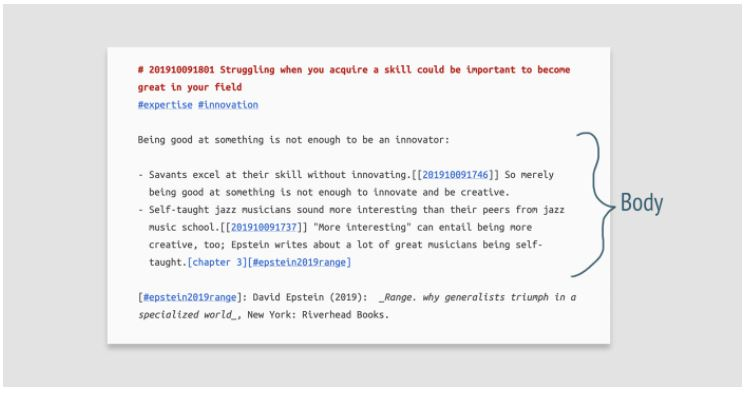
We create a Zettel note on a topic of interest then we Drag the links to the new Zettel.
In a non-linear format, we embed the Zettel Thread in the already existing notes. In the above example from Sascha [1] a new Zettel note is started. Thus starting a new thread. The other two links already exist as notes somewhere in your Zettelkasten.
201910091801
Struggling when you acquire a skill (title shortened for example) - Entry note.
Continue Thread: 201910091746
201910091746
Title: Savants excel at their skill without innovating.
" here is the quote that inspired this note"
Reference: XYZ article.
Path: Struggling when you acquire a skill. Continue Thread: 201910091737
Being good at something is not enough to be an innovator.
"So merely being good at something is not enough to innovate and be creative."
201910091737
Title: Self-taught jazz musicians sound more interesting than their peers from jazz music school.
"here is the quote that inspired this note"
Reference: ABC Book
(assume you pull up this note and two Zettel thread already exists)
Path: Jazz Music. Continue Thread: ...
Jazz Music is Great
"pithy comment about jazz music"
Path: Private School Costs. Continue Thread: ...
The cost of private schools is sky high!
"comments about private schools"
Path: Struggling when you acquire a skill. Continue Thread: end.
Being good at something is not enough to be an innovator.
"'More interesting' can entail being more creative, too; Epstein writes about a lot of great musicians being self-taught. Chapter 3 etc.
Potential Serendipity Three unique threads are crossing on this note. Is there something I can think about regarding the high cost of private schools and acquiring skills?
If I pull this link into a separate note, I'm not sure I'll see the potential for a connection. However, that's just me. The problem I kept running across with the "drag the link to the Zettel note," is the notes (even from an atomic level) grew too large. It was like reading a whole book again. Following the thread through existing links has helped immensely.
Real-world example:
In May of 2008, I read a Wall Street Journal article in which the author quotes an analyst as saying: "serial destroyers of wealth." I now have a Zettel thread that is called just that: "Serial destroyers of wealth." I've linked the thread to articles on CEOs who have almost bankrupted their companies and were fired receiving massive compensation. If their name shows up again in another article I want to know about it. I've added the thread to a company that several years ago claimed their patents were given to a Native American tribe in New York therefore they were beyond the reach of the governing body. That company was later bought by another company and you can be sure I want to track that for potential problems. My first note on blockchain (Bitcoin) technology dates to 1/24/2015. In my world, I prefer to create a new thread or better yet, tap into an existing thread and jump to the end or wander along the thread looking for ideas and new connections.
[1] Fast, Sascha. (2020, October 27). Zettelkasten. Retrieved November 07, 2020, from https://zettelkasten.de/introduction/
In my Zettelkasten books overlap and entry notes are by necessity inside the shaded areas.
I am a Zettler
This reminds me of a question/thought I had about common paths through edges with varied context despite the common subpath given different "long path context".
https://forum.zettelkasten.de/discussion/1907/multi-edges-named-links-sub-graph-a-means-of-capturing-fluid-associations#latest
@Steve625
Thanks again for a thoughtful and detailed response. I have read what you have said (carefully) and will study it more; it's still not entirely clicking in my brain as to how this differs from what I am currently doing. Maybe learning a bit about TheBrain will help.
@Steve625 I have probably read what you have written rather too quickly, so I apologise if I have missed something crucial, but it seems to me that what you are really describing has a lot to do with the potentialities and affordances of the program TheBrain. I have dabbled with it, and find it a hugely tempting program, but ruinously expensive. I would love to be able to use it, but cost holds me back. I grew up in a family of artists, so I find the visual representation of connections (and other visual affordances) to be highly attractive, and I often struggle with the linear presentation of information. For example, I seem to cope much better if my task lists are on a mind map (such as iThoughts), rather than in a conventional task manager. But I am going off topic. I will have to look at TheBrain again -- or rather at my bank account.
@MartinBB, you are perhaps correct. I have used the software for so many years the subtle intricacies could be lost on me. However, many of my notes are stand alone, i.e., a note with a UID, title, quote, and my prose. The note becomes part of my Zettelkasten through hyperlinks as I connect the note to different paths of interest. How is that different than what is being used elsewhere? The only "hard links" I use are when I want to keep an original author's intent from a book or article I am reading.
@Steve625 I think it may come down to the view that you see when you open the program. With TheBrain you see part of a network, and any step you make by selecting an item presents you with what is linked to that item (unless you are using the outline view, I think - not as familiar with the program as I would like). In many other programs one gets a list in a sidebar, which immediately gives a different impression. You are not seeing what is linked, but the most recent notes (depending on how you are sorting your files). With TheBrain you definitely get the impression of a lattice right from the start. With other programs you get a list, and when you conduct a search the result is still a list (unless you are using graph view in Obsidian, which does give a different visual presentation). Because of my background I tend to think that different visuals can lead to different thinking, or different interpretations. Or they can facilitate that.
@MartinBB, I am sure you are correct. Different impressions do lead to other thought processes. Just one final thought on the different formats. If I were to ask you to post a picture of your favorite Zettel note, what would it look like? Here's mine.
If you compile your Zettel notes in a linear format, your first reaction is going to be, "where is the body of your note"? In a nonlinear structure, you'll click the link to follow the thread. Perhaps just a minor difference, but all I need is a program that gives me a place to write and hyperlink capability. The rest is fluff. Sometimes nice fluff, to be sure, but fluff nonetheless.
@Steve625 "Favourite Zettel note" is a bit of an alien concept to me, and I think I could only answer it by saying that my favourite is whichever one I happen to be working on at the time!
But another thought has occurred to me, which is that I have probably spent much too much time trying to lay out each individual note -- usually so that it resembles a physical index card in some way. I'm not sure this is really useful with the tools we now have available. I have begun to find myself wanting something more visual, more creative, less restrictive. This may in part be because I have recently been finding pictures of paintings to share, and I am also reviewing a lot of my own photographs. In short, I am beginning to have to deal with a lot of disparate material that I need to bring together into a project that forms a cohesive "whole" rather than a load of bits and pieces. Various programs claim they can help you do that, but I struggle to find the right one for me.
I have rather wandered off the topic, but you have rekindled my interest in TheBrain, which I seem to remember is pretty good at handling images, and this is something I really need at the moment. However, it seems to me to be a program that you have to commit to fully, with no half measures, because once you get in it, you are not going to be able to switch to another program that easily. But it seems that David Allen of GTD uses (or used) the program, which must be some sort of recommendation, because I would imagine he could have his own programs written for him if he wanted. Writing and hyperlinking are certainly fundamentals, but I need images as well these days.
@MartinBB
There is a free version of TheBrain that I am playing with, just to get a sense of what the program can do. Perhaps its limited functionality is sufficient for your needs? It looks like the free version is still pretty capable:
https://www.thebrain.com/store/compare-editions
@GeoEng51 Yes, I've had it on my computer (and my phone!) for quite some time. It sits there and tempts me to spend money on it ... One of its limitations is no file attachments -- so no images, which is something I really need now.
One thing to keep in mind with TheBrain is the base architecture is not database-driven. Many of the new programs, i.e., Notion, are databases, and the interface allows you to manipulate the database to see what you want, not so with TheBrain. For example, TheBrain creates a file folder on your computer, and the interface will enable you to name it and connect it to other files. This is handy, and having a file-based program handles pictures and text efficiently, but one cannot create a database inside the program.
Yes, I see - no file attachments is a downer. Otherwise, the price is really steep. :>(
It is the main thing that is stopping me from using it. If you pay $16 a month perhaps it does not seem quite so bad, but it is still a lot compared with other solutions.
I see that notes are stored in the form of html, which could be useful. But the whole thing seems to be tied together with SQL databases. Not that I would be playing around with the internals.
It is a very interesting program. I just wish it were about a tenth of the price, which would be more in line with my budget constraints.
Haha! Maybe we could convince the producer to make a less expensive version available for non-commercial Zettelkasten use
What a fantastic thread! Thanks OP and Posters. Has anyone here in their travels encountered Obsidian? Seems to check off many of the desired issues mentioned, including attachments and wikilinks, to name two.
Yes - it's well known and discussed on the forum in numerous threads. I'm not a user myself, though, so can't comment on its capabilities.